Richard Godwin in The Guardian:
 Deisseroth, 49, is talking in the lush, squirrel-filled garden of his house in Palo Alto, northern California, where he has spent much of the pandemic looking after his four young children. But he has had much else on his mind. He has been finishing his book, Connections: A Story of Human Feeling, an investigation into the nature of human emotions. He has been meeting with psychiatric patients over Zoom as well as putting in night shifts as an emergency hospital psychiatrist. And he has fitted all of this around his day job, which is using tiny fibre-optic cables to fire lasers into the brains of mice that he has infected with cells from light-sensitive algae and then observing what happens, millisecond by millisecond, when he turns individual neurons on or off.
Deisseroth, 49, is talking in the lush, squirrel-filled garden of his house in Palo Alto, northern California, where he has spent much of the pandemic looking after his four young children. But he has had much else on his mind. He has been finishing his book, Connections: A Story of Human Feeling, an investigation into the nature of human emotions. He has been meeting with psychiatric patients over Zoom as well as putting in night shifts as an emergency hospital psychiatrist. And he has fitted all of this around his day job, which is using tiny fibre-optic cables to fire lasers into the brains of mice that he has infected with cells from light-sensitive algae and then observing what happens, millisecond by millisecond, when he turns individual neurons on or off.
This is the basic methodology of optogenetics, a technique that Deisseroth pioneered in 2005 with his team at what is now the Deisseroth Lab at Stanford University. It has been widely recognised as one of the great scientific breakthroughs of the 21st century.
More here.
